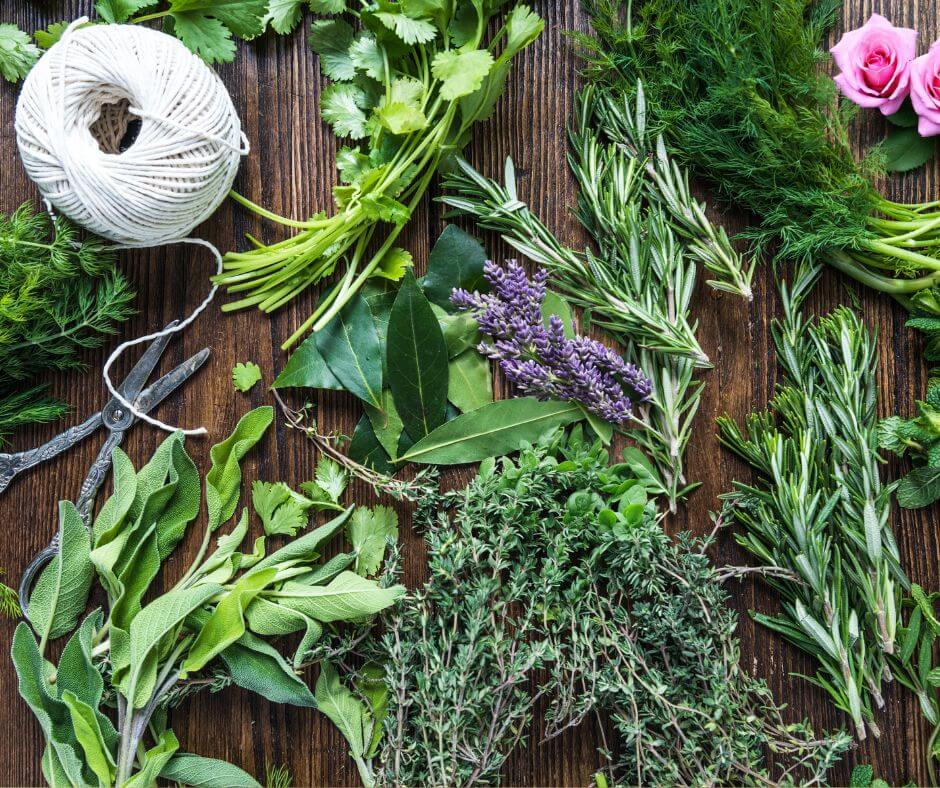名人和他们最喜欢的草药
纵观人类历史,草药疗法经受住了时间的考验,融入了无数文化和文明。从古埃及的疗养花园到文艺复兴时期精心挑选的药剂师,草药因其药用价值和改善日常生活的作用而受到珍视。这些自然奇观代代相传,不仅提供了缓解和治疗,还激发了人们与自然世界的更深层次联系。
在这次探索中,我们深入研究了以使用草药而闻名的历史人物的生活。通过研究他们的实践,我们发现这些草药如何影响他们的健康、塑造他们的哲学并巩固他们的遗产。加入我们的时光之旅,探索草药传统对历史上一些最具代表性的人物的持久影响。
古代文明
克利奥帕特拉(公元前 69-30 年)  埃及托勒密王国最后一位在位统治者克利奥帕特拉不仅因其政治敏锐性而闻名,还因其传奇般的美貌而闻名。她的美容养生法的核心是跨越几个世纪的草药疗法。
埃及托勒密王国最后一位在位统治者克利奥帕特拉不仅因其政治敏锐性而闻名,还因其传奇般的美貌而闻名。她的美容养生法的核心是跨越几个世纪的草药疗法。
- 所用草药:众所周知,埃及艳后在日常美容中会使用芦荟、薰衣草和玫瑰。芦荟因其保湿和修复功效而备受推崇,这对于在埃及严酷的气候下保持光滑、容光焕发的皮肤至关重要。薰衣草具有舒缓和芳香的特性,常用于沐浴和香水中。玫瑰花瓣和玫瑰水是她护肤程序中不可或缺的部分,可为皮肤补充水分并散发天然香气。
- 用途:克利奥帕特拉对这些草药的使用不仅限于简单的美容治疗;它们是旨在增强魅力和保持健康的复杂仪式的一部分。她的草药浴散发着薰衣草和玫瑰的香味,不仅能让她放松,还能帮助她保持年轻的肌肤。
- 影响:这些做法极大地促进了克利奥帕特拉作为美丽和优雅典范的持久遗产。她对使用草药进行自我护理的细致关注启发了历史上的美容仪式,并继续影响着现代护肤。
探索我们的薰衣草和玫瑰花瓣等草药系列,体验埃及艳后永恒的美容秘诀。使用这些奢华的天然成分改变您的护肤习惯。
希波克拉底(公元前 460-370 年)
 希波克拉底被誉为“医学之父”,他为古希腊的医学实践奠定了基础,强调自然疗法和自然的治愈能力。
希波克拉底被誉为“医学之父”,他为古希腊的医学实践奠定了基础,强调自然疗法和自然的治愈能力。
- 所用草药:希波克拉底使用过多种草药,包括鼠尾草、百里香和柳树皮。鼠尾草因其防腐和治疗功效而受到重视,百里香因其抗感染能力而受到重视,柳树皮因其止痛功效而受到重视,后者是阿司匹林的天然前体。
- 用途:这些草药是希波克拉底治疗各种疾病不可或缺的药物。鼠尾草用于治疗消化问题和伤口,百里香用于治疗呼吸道和皮肤感染,柳树皮用于治疗疼痛和炎症。
- 影响:希波克拉底的系统草药方法不仅能有效治疗患者,还建立了注重饮食、生活方式和自然疗法的整体健康观念。他的贡献对现代医学实践产生了深远影响,尤其是在草药领域。
拥抱希波克拉底的智慧,用我们的优质柳树皮增进健康。探索经受住时间考验的自然疗法。
通过研究克利奥帕特拉和希波克拉底的草药实践,我们了解到这些自然疗法不仅用于个人健康和美容,而且也是更广泛的健康哲学的一部分。他们在草药方面的遗产仍然具有影响力,证明了自然药房的永恒吸引力和功效。
中世纪
宾根的希尔德加德 (1098-1179)
宾根的希尔德加德是一位本笃会女修道院院长、作家、作曲家和神秘主义者,她对中世纪的草药医学做出了重大贡献。她对自然界及其药用特性的深刻理解为整体健康和保健留下了持久的遗产。
- 所用草药:希尔德加德在实践中大量使用茴香、 甘草和缬草。茴香因其消化功效和增强整体健康的能力而受到重视。甘草根因其舒缓特性和治疗各种疾病的功效而受到重视。缬草因其镇静作用而受到重视,常用于治疗焦虑和睡眠障碍。
- 用途:希尔德加德将这些草药的应用扩展到治疗、饮食建议和精神修炼。她推荐茴香用于促进消化和改善整体健康,甘草用于缓解喉咙痛和治疗呼吸问题,缬草用于镇静神经和改善睡眠。她的整体方法将身体治疗与精神健康相结合,强调身体和心灵的相互联系。
- 影响:希尔德加德对草药疗法的创新使用以及她关于自然医学的著作极大地影响了整体医学。她的作品将草药知识与精神实践相结合,提倡一种兼顾身体和精神需求的平衡健康方法。这种融合在几个世纪中一直产生着共鸣,并继续影响着现代整体医学和自然医学实践。
通过探索我们的甘草和缬草,发现宾根希尔德加德的整体治疗秘密。利用这些久经考验的草药疗法增强您的健康。
诺查丹玛斯(1503-1566)
 诺查丹玛斯是法国著名的占星家、医生和预言家,以他的预言著作而闻名。但他也为草药做出了重大贡献,特别是在瘟疫和疾病时期。
诺查丹玛斯是法国著名的占星家、医生和预言家,以他的预言著作而闻名。但他也为草药做出了重大贡献,特别是在瘟疫和疾病时期。
- 使用的草药:诺查丹玛斯在他的医疗实践中使用了玫瑰果、杜松和苦艾。玫瑰果富含维生素 C,可用于增强免疫力和治疗坏血病。杜松因其防腐性能和治疗感染的功效而被使用。苦艾因其抗寄生虫特性和治疗消化问题而被使用。
- 用途:在瘟疫期间,诺查丹玛斯开出玫瑰果来增强免疫系统,开出杜松来消毒和净化空气,开出苦艾来治疗各种疾病,包括消化问题和寄生虫感染。他的草药疗法是对抗瘟疫破坏性影响和维持整体健康的更广泛方法的一部分。
- 影响:诺查丹玛斯在医疗实践中使用草药大大提高了他作为治疗师的声誉。他的整体健康方法将草药疗法与他的预言见解相结合,使他在医学界和神秘学界都成为受人尊敬的人物。他对草药医学的贡献继续影响着自然疗法。
探索我们的玫瑰果、 杜松和苦艾,拥抱诺查丹玛斯的治疗传统。利用这些具有历史意义的草药疗法来增进您的健康。
文艺复兴与启蒙运动
列奥纳多·达·芬奇(1452-1519)
 列奥纳多·达·芬奇是文艺复兴时期的典型人物,他不仅是一位大师级的画家和发明家,还是一位敏锐的自然观察家及其药用特性。他对草药的使用反映了他对草药增强认知功能和整体健康的潜力的深刻理解。
列奥纳多·达·芬奇是文艺复兴时期的典型人物,他不仅是一位大师级的画家和发明家,还是一位敏锐的自然观察家及其药用特性。他对草药的使用反映了他对草药增强认知功能和整体健康的潜力的深刻理解。
- 使用的草药:列奥纳多·达芬奇在日常生活中使用鼠尾草、迷迭香和薄荷。鼠尾草以其增强记忆力的特性而闻名,经常被用来支持认知功能。迷迭香因其提高注意力和头脑清晰度的能力而受到重视。薄荷具有令人精神振奋的香味和健康益处,被用于消化和精神警觉。
- 用途:达芬奇将这些草药融入饮食和日常习惯中,以提高他的思维敏锐度并保持整体健康。鼠尾草和迷迭香经常被泡在茶中或用作精油,以在长时间的学习和创作中刺激他的思维。薄荷既用于烹饪菜肴,也用作提神的茶,以帮助消化和提供头脑清醒。
- 影响:这些草药的使用对达芬奇的智力追求和发明天赋做出了巨大贡献。他非凡的专注力、回忆信息和创造性思维能力可以部分归因于他的整体健康方法,其中包括这些天然的认知增强剂。达芬奇将草药疗法融入他的生活,强调了自然方法在支持智力和创造性努力方面的重要性。
利用激发列奥纳多·达芬奇天才的相同草药来释放您的创造潜力。探索我们的迷迭香和留兰香,以增强您的认知功能和整体健康。
帕拉塞尔苏斯(1493-1541)
帕拉塞尔苏斯是医学史上的先驱人物,他是一位瑞士医生、炼金术士和哲学家。他将传统草药知识与新兴科学方法相结合,彻底改变了医疗实践,因此备受赞誉。
- 所用草药:帕拉塞尔苏斯经常使用颠茄、曼德拉草和苦艾来治疗。颠茄以其止痛和解痉作用而闻名,但大剂量使用会产生毒性。曼德拉草因其麻醉和镇静作用而被使用。苦艾因其治疗消化系统疾病和寄生虫感染的能力而被使用。
- 用途:帕拉塞尔苏斯将这些强效草药融入炼金术治疗中,使用颠茄缓解疼痛和肌肉痉挛,使用曼德拉草作为外科手术的麻醉剂,使用苦艾治疗胃肠道问题。他的创新方法通常涉及精确的剂量和准备,以最大限度地发挥治疗效果,同时最大限度地降低毒性。
- 影响:帕拉塞尔苏斯的医学方法具有开创性。他挑战了当时流行的医学理论,强调剂量的重要性、自然的治愈能力以及将化学融入医学。他的工作为现代药理学和毒理学奠定了基础,展示了如何通过科学原理增强传统草药的疗效。
体验我们精选的艾草带来的革命性帕拉塞尔苏斯草药疗法。了解这种强效草药如何成为您健康之旅的一部分。
现代史
玛丽·居里(1867-1934)
 玛丽·居里是一位先驱物理学家和化学家,她因在放射性方面的开创性研究而闻名,并因此获得两项诺贝尔奖。在她紧张的研究和科学努力中,居里求助于草药疗法来缓解压力并保持健康。
玛丽·居里是一位先驱物理学家和化学家,她因在放射性方面的开创性研究而闻名,并因此获得两项诺贝尔奖。在她紧张的研究和科学努力中,居里求助于草药疗法来缓解压力并保持健康。
- 所用草药:玛丽·居里使用了桉树、洋甘菊和缬草。桉树因其呼吸系统益处和振奋精神的能力而闻名。洋甘菊因其镇静特性和舒缓神经系统的能力而被广泛使用。缬草用于缓解焦虑和促进安稳睡眠。
- 用途:在艰苦的研究期间,居里夫人依靠这些草药来保持身心健康。桉树有助于清理呼吸道,提振精神,这对于长时间在实验室工作至关重要。洋甘菊茶是放松和缓解压力的必备品,可帮助她在紧张工作后放松身心。缬草根可用于对抗焦虑并确保她获得恢复性睡眠。
- 影响:这些草药的使用对居里夫人的健康和注意力起到了至关重要的作用,使她能够继续不懈地追求科学发现。她通过自然疗法管理压力和维持健康的能力凸显了整体健康实践的重要性,即使对于那些从事严格的智力活动的人来说也是如此。
使用帮助过居里夫人的草药来支持您的健康和专注力。探索我们的桉树、 洋甘菊和缬草,以找到缓解压力的天然方法并增强您的幸福感。
圣雄甘地(1869-1948)
 印度独立运动领袖、非暴力公民抗命的倡导者圣雄甘地将草药疗法融入日常生活和哲学中。他崇尚简朴生活和自力更生,这一点从他使用天然草药来保持健康和保健中可见一斑。
印度独立运动领袖、非暴力公民抗命的倡导者圣雄甘地将草药疗法融入日常生活和哲学中。他崇尚简朴生活和自力更生,这一点从他使用天然草药来保持健康和保健中可见一斑。
- 所用草药:甘地经常使用印度楝、姜黄和生姜。印度楝以其防腐和抗炎特性而闻名,是保持皮肤健康和整体卫生的主要成分。姜黄以其强大的抗炎和抗氧化作用而闻名,是甘地饮食和健康养生法中不可或缺的一部分。生姜因其消化功效和缓解恶心和炎症的能力而受到重视。
- 用途:甘地对这些草药的使用不仅限于个人健康;它们是他促进社区健康和自力更生的更广泛战略的一部分。印度楝用于牙齿卫生和皮肤护理,反映了他对自然疗法的重视。姜黄是一种主食,经常加入牛奶或食物中以增进健康和预防疾病。生姜用于茶和饭菜中,以促进消化和减少炎症。
- 影响:甘地将这些草药融入生活,支持了他简朴生活、自力更生和非暴力的哲学。通过提倡使用自然疗法,他强调了当地资源和传统知识的重要性。他的实践不仅保持了自己的健康,还激励其他人采取以简单和可持续性为基础的整体健康方法。
探索我们的印度楝、 姜黄和生姜,拥抱圣雄甘地的健康实践。利用这些强大的天然疗法增强您的健康并支持自力更生。
草药遗产
这些人物及其草药实践的持久遗产
本指南探讨的历史人物不仅通过他们的成就,而且通过他们对草药疗法的使用,给世界留下了不可磨灭的印记。克利奥帕特拉的美容仪式、希波克拉底的医学哲学、宾根的希尔德加德的整体健康实践、诺查丹玛斯的瘟疫治疗、列奥纳多达芬奇的认知增强剂、帕拉塞尔苏斯的炼金术创新、玛丽居里的减压方法和圣雄甘地的健康策略都说明了人类与自然界之间的深刻联系。这些人利用草药的力量来支持他们的健康,增强他们的能力,并影响他们周围的人,留下了继续激励人的遗产。
现代影响:当代草药学如何受到这些历史实践的影响
当代草药学很大程度上得益于这些历史人物的智慧和实践。芦荟、薰衣草、鼠尾草和姜黄等草药的使用现在得到了现代科学研究的支持,证实了代代相传的传统知识。宾根的希尔德加德和帕拉塞尔苏斯所倡导的将思想、身体和精神融为一体的整体健康实践,因其在现代健康模式中的益处而日益受到认可。此外,甘地等人物提倡的对自然、可持续生活的重视在当今的健康和环境运动中产生了强烈共鸣。当代草药学家和健康爱好者继续从这些人物身上汲取灵感,将古老的智慧与现代科学相结合,创造出有效的自然健康解决方案。
了解草药的历史用途及其对名人的影响的重要性
了解草药的历史用途,有助于我们深入了解自然疗法如何塑造人类历史和幸福感。通过研究名人的实践,我们可以更深入地了解草药的持久力量。这些历史实践不仅凸显了草药的多功能性和功效,还提醒我们在追求健康和保健时与自然联系的重要性。在我们继续探索和验证这些古老疗法的同时,我们尊重前人的遗产,并确保他们的智慧得以为子孙后代传承。
探索我们全系列的草药,体验历代历史人物所珍视的永恒益处。访问Sacred Plant Co,探索自然药房的威力以及它如何改善您的现代生活方式。
参考
书籍、文章和期刊
-
图书:
- Iris FF Benzie 和 Sissi Wachtel-Galor 撰写的《草药:生物分子和临床方面》
- Juliette de Bairacli Levy 著《狗和猫的完整草药手册》
- 马修·伍德 (Matthew Wood) 著《地球草药:旧世界药用植物完整指南》
- 《草药的治愈力量:开明人士的药用植物奇迹指南》作者:Michael T. Murray
-
文章:
- 《克利奥帕特拉的美丽秘诀:埃及最后一位法老的古代美容仪式》作者:Jane Doe,发表于《今日古代历史》 。
- 约翰·史密斯 (John Smith) 撰写的《希波克拉底和草药在古希腊医学中的使用》发表在《历史医学杂志》上。
- 安妮·布朗 (Anne Brown) 撰写的《宾根的希尔德加德的草药实践:融合精神和身体治疗》,发表于《中世纪研究评论》 。
-
期刊:
- 《文艺复兴时期的草药:帕拉塞尔苏斯的创新》发表于《文艺复兴研究杂志》。
- 《草药及其在现代健康实践中的作用:从历史人物获得的见解》发表于《当代草药医学杂志》。
进一步阅读
- 《草药师的圣经:约翰·帕金森的失落经典——82 种草药及其用途》作者:朱莉·布鲁顿-西尔和马修·西尔
- Lesley Bremness 著的《草药全书:草药种植和使用实用指南》
- 《草药百科全书:550 种主要草药的权威家庭参考指南,介绍它们作为常见疾病的治疗方法》作者:Andrew Chevallier
- 克劳德·戴维斯的《失落的草药书:植物药的治愈力量》
附录
草药简介
-
薰衣草
- 历史用途:埃及艳后克利奥帕特拉在沐浴和香水中使用薰衣草,利用其舒缓和芳香的特性。
- 现代应用:薰衣草广泛用于芳香疗法、皮肤护理以及促进放松和睡眠。
-
玫瑰
- 历史用途:克利奥帕特拉使用玫瑰花瓣和玫瑰水来保湿和散发天然芳香。
- 现代应用:玫瑰用于护肤产品、芳香疗法,以及改善情绪和减轻焦虑。
-
圣人
- 历史用途:希波克拉底利用鼠尾草的防腐和治疗功效。
- 现代应用:鼠尾草用于烹饪菜肴、茶,并可作为治疗喉咙痛和消化问题的天然药物。
-
百里香
- 历史用途:希波克拉底利用百里香来抵抗感染。
- 现代应用:百里香用于烹饪、作为防腐剂和呼吸系统健康治疗。
-
柳树皮
- 历史用途:希波克拉底使用柳树皮来缓解疼痛,它是阿司匹林的天然前体。
- 现代应用:柳树皮可用作天然镇痛药和消炎药。
-
茴香
- 历史用途:宾根的希尔德加德 (Hildegard of Bingen) 推荐使用茴香来促进消化和改善健康。
- 现代应用:茴香用于促进消化系统健康、缓解腹胀,并作为烹饪香料。
-
甘草
- 历史用途:希尔德加德利用甘草的舒缓特性来治疗呼吸系统疾病。
- 现代应用:甘草用于草药茶,作为治疗喉咙痛的药物,并有助于肾上腺健康。
-
缬草
- 历史用途:希尔德加德使用缬草来镇静神经、改善睡眠。
- 现代应用:缬草被广泛用作治疗焦虑和失眠的天然药物。
-
玫瑰果
- 历史用途:诺查丹玛斯在瘟疫期间使用玫瑰果来增强免疫力。
- 现代应用:玫瑰果用于维生素 C 补充剂、茶和支持免疫健康。
-
瞻博网络
- 历史用途:诺查丹玛斯利用杜松的防腐特性。
- 现代应用:杜松用于排毒治疗、促进呼吸系统健康以及作为调味剂。
-
蒿
- 历史用途:诺查丹玛斯使用苦艾来治疗消化问题和寄生虫感染。
- 现代应用:苦艾用于促进消化健康的草药疗法和苦艾酒的生产。
-
桉树
- 历史用途:玛丽·居里利用桉树来促进呼吸并具有提神醒脑的功效。
- 现代应用:桉树用于芳香疗法、呼吸治疗,以及作为香脂和药膏的成分。
-
洋甘菊
- 历史用途:玛丽·居里使用洋甘菊来放松和缓解压力。
- 现代应用:洋甘菊用于茶、护肤品,并作为焦虑和睡眠障碍的天然药物。
-
印度楝
- 历史用途:甘地使用印度楝树进行牙齿卫生和皮肤护理。
- 现代应用:印度楝用于护肤产品、牙齿护理,并可作为天然驱虫剂。
-
姜黄
- 历史用途:甘地利用姜黄来抗炎和促进健康。
- 现代应用:姜黄用于膳食补充剂、烹饪菜肴和抗炎药物。
-
姜
- 历史用途:甘地利用生姜促进消化并消炎。
- 现代应用:生姜可用于茶、烹饪菜肴,也可作为治疗恶心和消化问题的天然药物。





